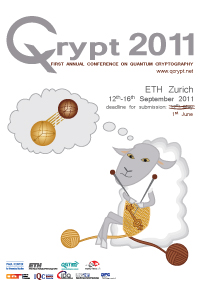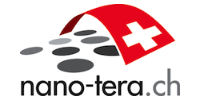|
|||||||||||
Quantum Memories for Quantum Networks and Device-Independent QKD
Nicolas Gisin, Hugo Zbinden, Mikael Afzelius, F. Bussières, C. Osorio, N. Sangouard, R. Thew, N. Timoney, Ch. Clausen, Ch. Lim, I. Usmani, N. Walenta (Group of Applied Physics, University of Geneva, Switzerland)
There are two main Grand Challenges for academic research in quantum
communication. The first one aims at futuristic continental scale quantum networks.
The second one concerns “device independent QKD”, that is an implementation of
Quantum Key Distribution that exploits the nonlocal correlation observed in violations
of Bell’s inequality to realize “self testing QKD apparatuses”.
Direct point-to-point fiber optic based quantum communication is limited
by losses. For example, even with a perfect 10 GHz single-photon source and 100%
efficient single-photon detectors, the expected time for a photon to be detected after
1000 km of optical fibers is ridiculously low: more than 3 centuries! The only way to
overcome this severe distance limitation is the use of quantum repeaters based on
multimode quantum memories. We present a protocol for a solid-state multimode
quantum memory and illustrate its potential with experimental results, including two
crystal entanglement and violation of Bell inequality between a single-photon and
a crystal. The European project QuRep gathers groups from Switzerland, France,
Germany and Sweden to explore this technology with the aim of clearing the road for
a future industrial project.
QKD is the most advanced application of quantum communication. Its
principle has been proven to be secure, contrary to complexity based cryptography
that rests on unproven assumptions. However, any implementation of the principle
of QKD is necessarily only an approximation to the ideal protocol. Hence, one has
to thoroughly test QKD system for possible loopholes or side channels. A very
elegant solution, that would greatly simplify the testing, exploits nonlocal correlations.
Intuitively, if the correlation between Alice and Bob is nonlocal (i.e. violates Bell’s
inequality), then there are no local variables and, a fortiori, no adversary could hold
a copy of the nonexisting local variables. This intuition has recently been put on
solid ground, the security could be proven against all possible collective attacks.
However, it is well known that all optical violation of Bell’s inequality so far suffered
from the detection loophole. Interestingly, this has turned the detection loophole
problem from a philosophical question to an applied physics problem. We present a
realistic, though challenging, way of realizing a laboratory demonstration of Device
Independent QKD free of the detection loophole.
Wichtiger Hinweis:
Diese Website wird in älteren Versionen von Netscape ohne
graphische Elemente dargestellt. Die Funktionalität der
Website ist aber trotzdem gewährleistet. Wenn Sie diese
Website regelmässig benutzen, empfehlen wir Ihnen, auf
Ihrem Computer einen aktuellen Browser zu installieren. Weitere
Informationen finden Sie auf
folgender
Seite.
Important Note:
The content in this site is accessible to any browser or
Internet device, however, some graphics will display correctly
only in the newer versions of Netscape. To get the most out of
our site we suggest you upgrade to a newer browser.
More
information







